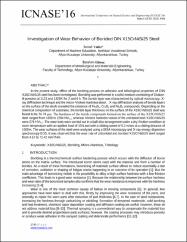Investigation of wear behavior of borided dın x15crnisi25 steel
Abstract
In the present study, effect of the boriding process on adhesion and tribological properties of DIN
X15CrNiSi25 steel has been investigated. Boriding was performed in a solid medium consisting of Ekabor-
II powders at 1123 and 1323K for 2 and 6 h. The boride layer was characterized by optical microscopy, Xray
diffraction technique and the micro-Vickers hardness tester. . X-ray diffraction analysis of boride layers
on the surface of the steels revealed the existence of FexBy, CrxBy and NixBy compounds. Depending on the
chemical composition of substrates, the boride layer thickness on the surface of the X15CrNiSi25 steel was
found to be 56.74 μm. The hardness of the boride compounds formed on the surface of the X15CrNiSi25
steel ranged from 1658 to 2284 HV0,1, whereas Vickers hardness values of the untreated steel X15CrNiSi25
were 276 HV0,1. The wear tests were carried out in a ball-disc arrangement under a dry friction condition at
room temperature with an applied load of 10N and with a sliding speed of 0.3 m/sec at a sliding distance of
1000m. The wear surfaces of the steel were analyzed using a SEM microscopy and X-ray energy dispersive
spectroscopy EDS. It was observed that the wear rate of unborided and borided X15CrNiSi25 steel ranged
from 4.57 to 71.42 mm3/Nm.
Source
International conference on natural science and engineering (ıcnase’16)URI
https://www.researchgate.net/profile/Ismail_Yildiz/publication/315113991_ICNASE'16_Investigation_of_Wear_Behavior_of_Borided_DIN_X15CrNiSi25_Steel/links/58cafac3a6fdccdf531a50e7/ICNASE16-Investigation-of-Wear-Behavior-of-Borided-DIN-X15CrNiSi25-Steel.pdfhttps://hdl.handle.net/11630/7426
Collections
- Bildiri Metinleri [20]



















